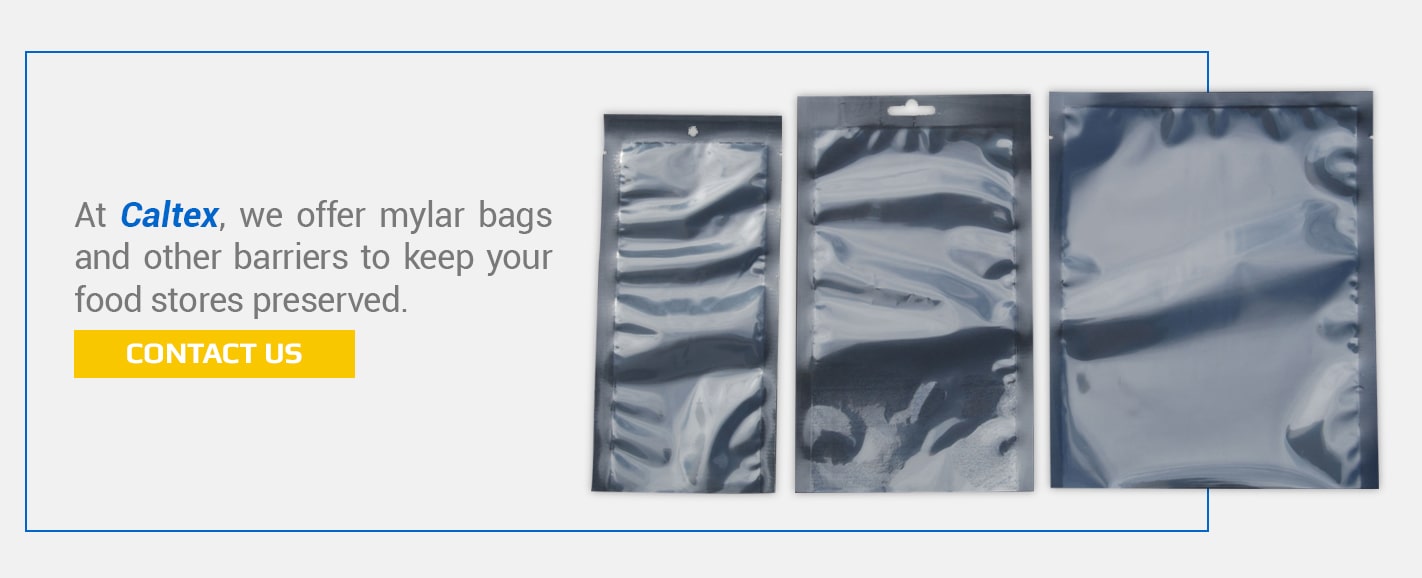HOW TO STORE FOOD FOR LONG TERM STORAGE IN CASE OF EMERGENCY
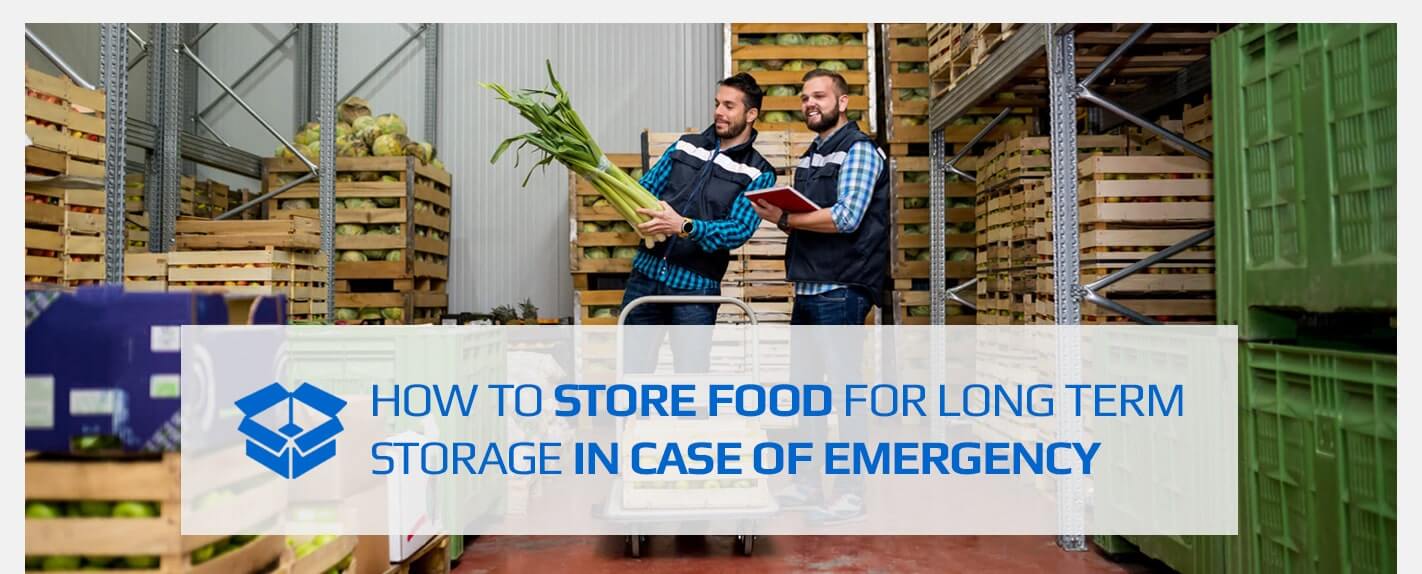
Posted: July 15th, 2019 Author: Jim Higgs
TABLE OF CONTENTS
Why Is It Important to Store Food Long Term?
How Much to Store for an Emergency?
What Foods Have the Longest Shelf Life for Prepping Storage?
Extra Goods to Store With Food
What Is the Best Packaging for Food Storage?
How to Store Food in Mylar Bags
How Long Does Food Last in Mylar Bags?
Where to Keep Your Food Storage?
Be prepared for any emergency with a ready supply of healthy, sustainable food to keep you going. No matter where you live in the country, you have a risk of experiencing natural disasters. Whether a hurricane blows through your town or a mudslide blocks a highway, at any time, you could find yourself without access to a grocery store. For such situations, having food stored can save your life and make the emergency easier to deal with.
WHY IS IT IMPORTANT TO STORE FOOD LONG TERM?
Food is a basic necessity of life that does not change regardless of outside circumstances. No matter what happens, you and your family will still need to eat. In 2005, Hurricane Katrina effectively cut off New Orleans for weeks. During that time, residents remained in the dark as they awaited power line repairs, and grocery store shelves stayed bare as flooded roads blocked food deliveries to the area. Those in the city needed to rely on their personal food stores until power could return and stores could reopen. Being prepared with healthy food on hand will give you the fuel you need to keep going.
While most food storage experts recommend storage for only a few days, some disasters, like Hurricane Katrina, can leave you on your own for much longer. You will need to prepare your home to shelter in place for a long time if you want to be ready for anything. While you never want to experience a severe emergency such as a hurricane, going through that experience without enough food would be even worse. Even as you hope for the best, plan for the worst-case scenario to ensure you’re always ready.
HOW MUCH TO STORE FOR AN EMERGENCY?
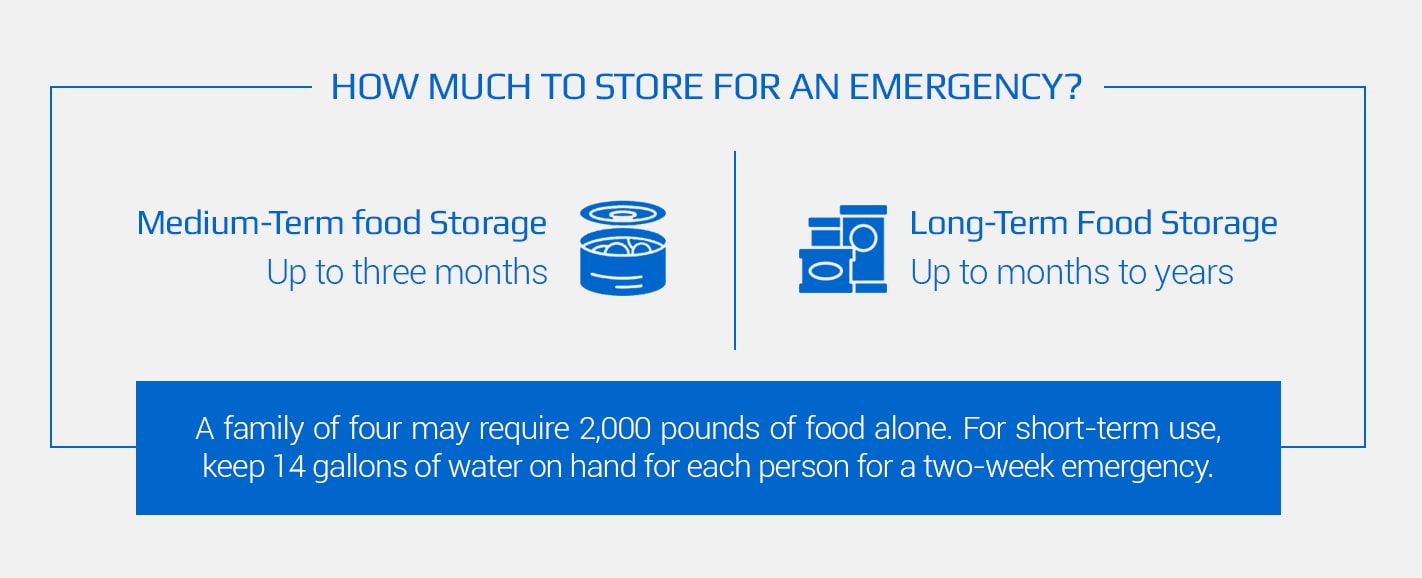
The amount of food you need for emergencies depends on how long you need to prepare for. While basic emergencies only require a three-day food supply per person, if you need food storage to last weeks up to years, you need to make careful calculations based on energy and vitamin and mineral requirements.
1. MEDIUM-TERM STORAGE FOR WEEKS
If you need food to last for up to three months, you can focus on comforting, satisfying meals that will give you and your family the calories they need. Plan the same rations and water amount for up to three months the same as you would plan for food storage of three days. Get extra food whenever you shop as most commercially canned goods will last for a few weeks. Don’t worry about vitamin deficiencies for such a short time. However, if you need food for more than three months, you must allow plenty of space.
2. LONG-TERM FOOD STORAGE
Long-term food storage requires more planning and specialized equipment than short or medium-term storage. You need to start now if you want to build a long-term store of food to carry you and your family through an emergency.
When you store food that you and your family will live off for months to years, you must provide everyone with enough calories and vitamins to keep them healthy. Per adult, you will need the following:
- 60 pounds of dried beans
- 400 pounds of grain
- 16 pounds of powdered milk
- 10 quarts of oil
- 8 pounds of salt
- 60 pounds of sugar
Yes, this is a lot of food. A family of four may require 2,000 pounds of food alone. That does not account for water or the supplies you need to cook and eat the food. For short-term use, keep 14 gallons of water on hand for each person for a two-week emergency. Long-term water supplies should include water purification tablets or other means of making the water you have safe to drink.
When building long-term food storage, always rotate your stock. First, eat the food that you have stored the longest. If a year passes without an emergency, check your stored food and eat anything close to its expiration and replace it with fresh food. Regularly monitoring your food stores will ensure the food you have on hand is always ready when you need it.
WHAT FOODS HAVE THE LONGEST SHELF LIFE FOR PREPPING STORAGE?
You need to know how to prepare food for long term storage before you begin. Generally, foods with low-moisture and fat levels have the most extended storage lives when stored correctly. When archaeologists opened an Egyptian tomb, they discovered 4,000-year old wheat inside that was still edible. While you may not get thousands of years of shelf life from your foods, you can extend their freshness by years with the right storage vessels and environment. With the proper storage, such as mylar bags, you can keep the following foods for at least 30 years:
- Beans
- Peas
- Lentils
- Wheat
- Rice
- Oats
- Dry Pasta
- Sugar
- Salt
- Baking Powder
- Baking Soda
- Dried Apples
- Potato Flakes
EXTRA GOODS TO STORE WITH FOOD
Be sure you can eat the food you have stored. Keep a grain mill on hand for grinding your grains. Stock water purification methods, such as tablets or bleach. Don’t forget cleaning materials such as soap and hand sanitizer. These will prevent illness when your body is already under stress from the emergency. Store several manual can openers with your canned goods. Also, have disposable utensils and plates so you don’t need to use water for cleaning.
Don’t forget pet food, coffee, cocoa mixes, dried drink mixes and comfort foods. If you have an infant, store powdered baby formula that your child can digest. Keeping your pets and youngest family members in mind during preparation will ensure they stay happy and healthy through the emergency.
WHAT IS THE BEST PACKAGING FOR FOOD STORAGE?
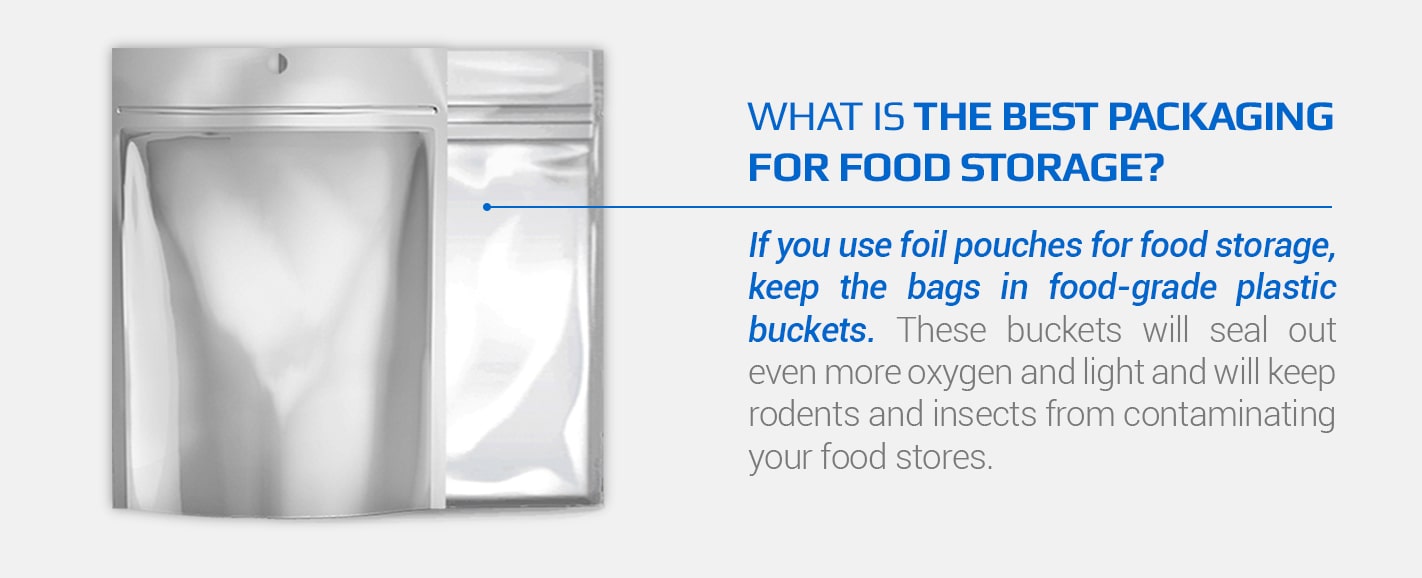
The best packaging for food storage keeps out oxygen, rodents, insects and light. Mylar bags, also known as foil pouches, block out light and oxygen from the food inside. These bags are an ideal solution to storing large and small quantities of dried foods. The only thing mylar bags cannot protect against is rodents.
Rodents can gnaw through a large variety of materials. If you use foil pouches for food storage, keep the bags in food-grade plastic buckets. These buckets will seal out even more oxygen and light and will keep rodents and insects from contaminating your food stores. If sealed properly and stored in ideal conditions, food kept in plastic buckets can last up to five years or even 20 years if oxygen absorbers are used.
Regardless of your packaging, dry foods such as rice and beans store best in oxygen-free, cool and dark environments. Dry or dehydrated foods should have moisture contents below 10 percent. Moist foods in an oxygen-free container are more prone to developing deadly botulism toxin, which is another reason to use dried foods for emergency rations.
HOW TO STORE FOOD IN MYLAR BAGS – VACUUM SEALING
Dried foods store best in air-tight containers without oxygen. If you use foil pouches for long term food storage, you must eliminate oxygen from inside after you’ve filled them with dried food. Removing oxygen prevents spoilage and kills any insect eggs that could hatch. Never store moisture-rich foods in foil pouches as this material is designed to hold dry foods better.
For mylar bags, add oxygen absorbers to the container and vacuum seal it to keep the package air-tight. For every gallon of food, use one 300cc oxygen absorber or a 2,000cc oxygen absorber for a five-gallon bucket. For powdery foods, use a heat-sealing device instead of a vacuum sealer to prevent powder from compromising the seal. Never substitute a home clothes iron for a heat-sealing device. Irons will not get hot enough nor produce a complete seal on the packaging. Plan on each one-gallon bag holding seven pounds of grain.
When sealing the bags, always check the integrity of the seal. You should not be able to pull the seal apart. If you can, slightly increase the temperature on the sealer. Improper seals could also occur if something is blocking the area, the bag is too full or the sealer needs cleaning. If the sealed area has scorch marks, you have the sealer temperature too high. Burned areas could compromise the material by thinning it from excessive heat levels.
After you’ve sealed the bags, place them in resealable plastic buckets. Food-grade 5-gallon buckets made of high-density polyethylene (HDPE) allow for a reduced transfer of oxygen into the container. Because oxygen can still get into a bucket, the storage life for these containers is only about five years. However, putting sealed mylar bags into the bucket dramatically extends the storage life because oxygen will not permeate the bags.
Another method of using foil bags is as liners for buckets, especially if you are not sure whether they can store food. Line the bucket with a mylar bag, add the food and insert oxygen absorbers. Fold the top of the bag over and seal the bucket. The air-tight seal on the bucket should keep out oxygen. For even longer storage, you could use a heat seal for the mylar liner.
HOW LONG DOES FOOD LAST IN MYLAR BAGS?
How long food lasts in mylar bags depends on the type of food, whether you sealed the bag and the storage conditions. Moist foods, such as home or commercially canned goods, in mylar packaging last no more than ten years, but storing moisture-rich foods is not recommended due to the increased likelihood of botulism. Dried foods, like beans and grains, can last 20 to 30 years when stored correctly in sealed foil bags.
Because storing dried foods in mylar bags sealed inside a food-grade bucket is the best storage method, foods stored in this manner can reach their maximum shelf lives. As discussed above, the longest lasting foods tend to have low moisture and fat levels.
WHERE TO KEEP YOUR FOOD STORAGE?
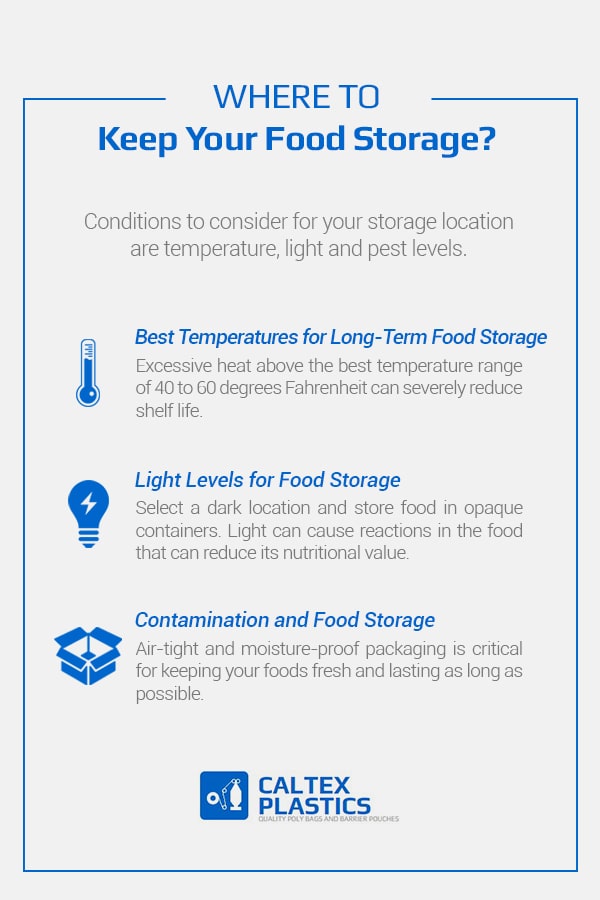
Planning your food storage requires the right conditions and adequate, safe space for your stores. First, find a cool, dry location with plenty of space, since you could need room for several thousands of pounds of food, depending on how many people are in your home and how long you need the food stores to last. Conditions to consider for your storage location are temperature, light and pest levels.
1. BEST TEMPERATURES FOR LONG-TERM FOOD STORAGE
Do not use an attic or garage for your food storage. These locations have temperatures that fluctuate wildly throughout the year. Dramatic temperature swings can shorten the storage life of your food. Excessive heat above the best temperature range of 40 to 60 degrees Fahrenheit can severely reduce shelf life. For every 10.8 degrees in temperature above this ideal range, the shelf life can cut in half. Find a climate-controlled part of your home.
2. LIGHT LEVELS FOR FOOD STORAGE
Select a dark location and store food in opaque containers. Light can cause reactions in the food that can reduce its nutritional value. While the food will remain edible, it will not provide as many vitamins and minerals as it would if you had it in the dark. Proteins and vitamins A, E and D are most susceptible to breaking down in light conditions. These nutrients are vital for keeping you going. Don’t risk missing out on them by improperly storing your food.
3. CONTAMINATION AND FOOD STORAGE
While mylar bags are ideal for keeping out light and oxygen, they can be nibbled through by rats. Buckets protect food in mylar packaging from pests, but you still want to store your food in an area that is as pest free as possible. Keep the buckets with food in them off the floor to further discourage pests from entering them. Using oxygen absorbers prevents the growth of insects inside the containers from any naturally occurring eggs that may have been in the food. Insect eggs are especially problematic with grains. Removing the oxygen kills the bugs before they can contaminate your food.
Air-tight and moisture-proof packaging is critical for keeping your foods fresh and lasting as long as possible. Moisture can degrade the quality of food and, in some cases, make it unsafe. Keeping food off the floor prevents moisture from humidity or floodwaters from reaching the storage containers. Because moisture in food reduces its shelf life, foods with less than 10 percent moisture have the longest storage times.
CALTEX, YOUR QUALITY FOOD STORAGE PACKAGING PROVIDER
Make your investment in emergency food last. To do so, you need confidence in your food-grade packaging. At Caltex, we offer mylar bags and other barriers to keep your food stores preserved. If you want to order our products or have any questions, feel free to contact us. We have 24/7 operations to offer you the best service possible for your food storage needs. Trust us to be your quality food storage packaging provider for when you need to rely on your long-term food stores for emergencies.
